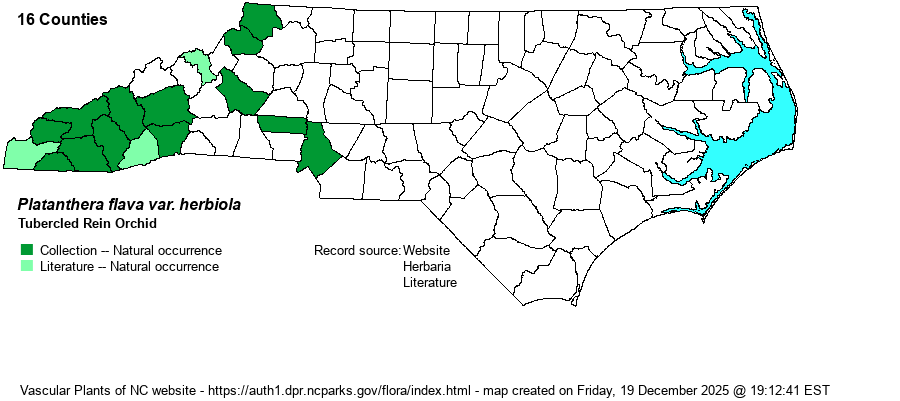| Author | (R. Br. ex Ait. f.) Luer | |
| Distribution | This taxon was considered as a full species -- Platanthera herbiola -- for a few years by Weakley in his floras; however, in 2023 he moved this taxon back to a variety of P. flava. This is the montane portion of the full species' range in the state. In NC, it occurs throughout the southwestern third of the Mountains, and is scattered farther northward in that region. It apparently sparingly occurs in the adjacent Piedmont; P. flava var. flava is found in the central and eastern Piedmont.
This variety ranges north to Quebec and MN, and then south to GA, TN, and MO -- essentially from the Appalachian Mountains westward. | |
| Abundance | Rare to uncommon from Buncombe County southwestward, but quite rare north toward the VA border. This is a State Special Concern taxon. | |
| Habitat | It occurs in bogs, seepages, and other wet places, such as in swampy forested sites. | |
| Phenology | Blooms from May into September, and fruits shortly after blooming. | |
| Identification | This variety is quite similar to var. flava in growth form, as both have a narrow raceme (looking like a spike) of pale green or yellow-green flowers. This variety is a bit larger than var. flava, growing up to 2 feet tall, and it has quite conspicuous leaf-like bracts that are much longer than the flowers above them. It has larger and longer stem leaves than does var. flava, and these often cover the stem and reach the bottom of the flower cluster. The flowers are similar to those of var. flava, being very small and facing downward. The var. herbiola is also separated from var. flava by the greener lip (instead of yellow-green) and by the flowers being denser in the raceme. Inexperienced biologists will likely overlook this variety, as the whole plant looks light green and at a distance it could look like a plantain (Plantago) or some other "non-orchid", even a grass! Thankfully, the plants often grow in a dense stand of several dozen plants, and such a stand should catch the eye. | |
| Taxonomic Comments | Probably more references consider this as just a variety -- Platanthera flava var. herbiola -- than as a good species. Note that nearly all Platanthera species were placed in the genus Habenaria a few decades ago. In fact, RAB (1968) did not list separate varieties, but did mention that the two forms were "variants".
| |
| Other Common Name(s) | This taxon has a number of common names in use, as might be expected, as P. flava var. flava does as well. Other common names include Pale-green Orchid, Tubercled Orchid, Northern Tubercled Bog Orchid. Several of these are the same as for var. flava, which goes against "rules" of common name usage. | |
| State Rank | S1S2 | |
| Global Rank | G5T5 [G5] | |
| State Status | SC-V | |
| US Status | | |
| USACE-agcp | | |
| USACE-emp | | |

